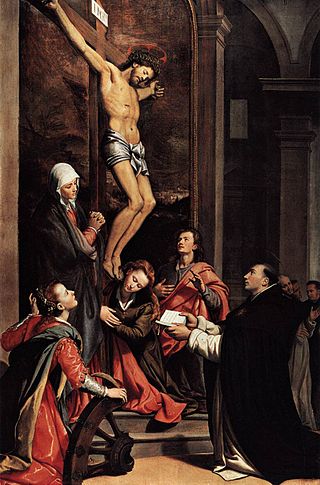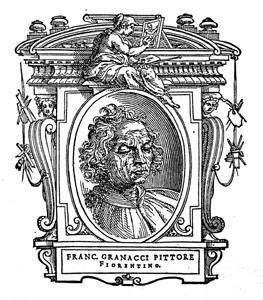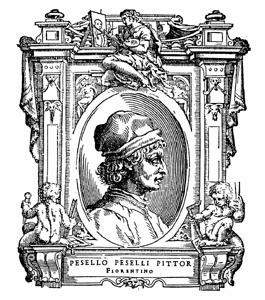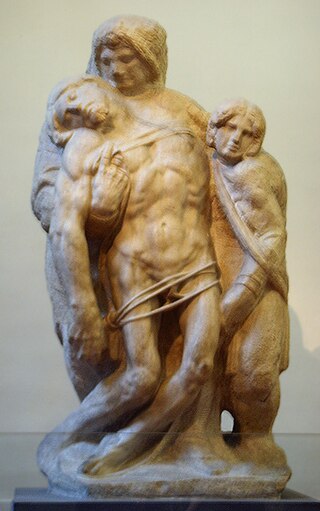- Annunciation (detail of Mary), Santa Prassede
- Annunciation (angel side), Santa Prassede
- Faith and Justice, Santa Prassede
- Pietà, San Marcello in Pistoia
- The Sacrifice of Isaac, 1585, Galleria dell'Accademia
- Pietà, 1587, Galleria dell'Accademia
Related Research Articles

Paolo Uccello, born Paolo di Dono, was an Italian painter and mathematician who was notable for his pioneering work on visual perspective in art. In his book Lives of the Most Excellent Painters, Sculptors, and Architects, Giorgio Vasari wrote that Uccello was obsessed by his interest in perspective and would stay up all night in his study trying to grasp the exact vanishing point. Uccello used perspective to create a feeling of depth in his paintings. His best known works are the three paintings representing the battle of San Romano, which were wrongly entitled the Battle of Sant'Egidio of 1416 for a long period of time.

Giorgio Vasari was an Italian Renaissance painter and architect, who is best known for his work Lives of the Most Excellent Painters, Sculptors, and Architects, considered the ideological foundation of all art-historical writing, and still much cited in modern biographies of the many Italian Renaissance artists he covers, including Leonardo da Vinci and Michelangelo, although he is now regarded as including many factual errors, especially when covering artists from before he was born.

Domenico di Tommaso Curradi di Doffo Bigordi, professionally known as Domenico Ghirlandaio, was an Italian Renaissance painter born in Florence. Ghirlandaio was part of the so-called "third generation" of the Florentine Renaissance, along with Verrocchio, the Pollaiolo brothers and Sandro Botticelli.

Lorenzo Monaco was an Italian painter and miniaturist of the late Gothic to early Renaissance age. He was born Piero di Giovanni. Little is known about his youth, apart from the fact that he was apprenticed in Florence. He has been considered the last important exponent of the Giotto style, before the Renaissance revolution that came with Fra Angelico and Masaccio.

Domenico di Michelino (1417–1491) was an Italian Renaissance painter who was born and died in Florence. His birth name was Domenico di Francesco. The patronymic "di Michelino" was adopted in honour of his teacher, the cassone painter Michelino di Benedetto, by whom no works have been identified. Giorgio Vasari reports that Domenico was also a pupil of Fra Angelico, whose influence is reflected in many of Domenico's paintings along with that of Filippo Lippi and Pesellino.

The Accademia di Belle Arti di Firenze is an instructional art academy in Florence, in Tuscany, in central Italy.

Pietro Perugino, an Italian Renaissance painter of the Umbrian school, developed some of the qualities that found classic expression in the High Renaissance. Raphael became his most famous pupil.

Santi di Tito was one of the most influential and leading Italian painters of the proto-Baroque style – what is sometimes referred to as "Counter-Maniera" or Counter-Mannerism.

The Galleria dell'Accademia di Firenze, or "Gallery of the Academy of Florence", is an art museum in Florence, Italy. It is best known as the home of Michelangelo's sculpture David. It also has other sculptures by Michelangelo and a large collection of paintings by Florentine artists, mostly from the period 1300–1600. It is smaller and more specialized than the Uffizi, the main art museum in Florence. It adjoins the Accademia di Belle Arti or academy of fine arts of Florence, but despite the name has no other connection with it.

Raffaellino del Garbo (1466–1527) was a Florentine painter of the early Renaissance.

Ridolfo di Domenico Bigordi, better known as Ridolfo Ghirlandaio was an Italian Renaissance painter active mainly in Florence. He was the son of Domenico Ghirlandaio.

Francesco Granacci was an Italian Renaissance painter active primarily in his native Florence. Though little-known today, he was regarded in his time and is featured in Giorgio Vasari's Lives of the Artists.

Agostino Ciampelli was an Italian painter of the Baroque period. He trained with Santi di Tito in Florence, and painted in Rome under Clement VIII, including a Crucifixion for Santa Prassede and a Saint Giovanni Gualberto in its sacristy; Angels on the walls above the choirstalls in the apse of Santa Maria in Trastevere; frescoes of the Stoning of Saint Vitale in San Vitale and further frescoes in the little church of Santa Bibiena; and The Visitation in Sant Stefano di Pescia. At the Basilica of San Giovanni in Laterano, Ciampelli frescoed the walls of the canons' sacristy, the "Sala Clementina".

Lorenzo di Bicci was an Italian painter of the Florentine School considered to be one of the most important painters in Florence during the second half of the 14th century. He is believed to have learned his trade from his father, about whom little is known. Lorenzo’s style, as well as that of his contemporaries Jacopo di Cione and Niccolò di Pietro Gerini, was influenced by the artist Andrea di Cione. Lorenzo's paintings made use of bright colors and his compositions avoided complexity. The figures he painted tended to have round faces and were often expressionless. Another one of Lorenzo's distinctive characteristics was his precision of execution. He was known for exceptional talent in drawing, an ability that he put to use at the initial stages of his painting. Unlike many celebrated Florentine artists of this period, Lorenzo mostly received commissions from the country clergy and from the lower-middle-class Florentine guilds. His successors, Bicci di Lorenzo and Neri di Bicci, continued to serve these groups.

Francesco Pesellino, also known as Francesco di Stefano, was an Italian Renaissance painter active in Florence. His father was the painter Stefano di Francesco, and his maternal grandfather was the painter Giuliano Pesello (1367–1446), from whose name the diminutive nickname "Pesellino" arose. After the death of his father in 1427, the young Pesellino went to live with his grandfather whose pupil he became. Pesellino remained in his grandfather's studio until the latter's death, when he began to form working partnerships with other artists, such as Zanobi Strozzi and Fra Filippo Lippi. He married in 1442, and probably joined the Florentine painters' guild in 1447. In the following years he made for reputation with small, highly-finished works for domestic interiors, including religious panels for private devotional use and secular subjects for pieces of furniture.

Bastiano di Bartolo Mainardi (1466–1513) was an Italian painter of the Early Renaissance. He was born in San Gimignano and was active there and in Florence.

The Palestrina Pietà is a marble sculpture of the Italian Renaissance, dating from c. 1555 and now in the Galleria dell'Accademia, Florence. It was formerly attributed to Michelangelo, but now it is mostly considered to have been completed by someone else, such as Niccolò Menghini or Gian Lorenzo Bernini. According to the Galleria dell'Accademia, the sculpture's "attribution to the master is still somehow controversial".

The Accademia delle Arti del Disegno is an academy of artists in Florence, in Italy. It was founded on 13 January 1563 by Cosimo I de' Medici, under the influence of Giorgio Vasari. It was initially known as the Accademia e Compagnia delle Arti del Disegno. It was made up of two parts: the company was a kind of guild for all working artists, while the academy was for more eminent artistic figures of the Medici court, and supervised artistic production in the Duchy of Florence.

Andrea del Sarto was an Italian painter from Florence, whose career flourished during the High Renaissance and early Mannerism. He was known as an outstanding fresco decorator, painter of altar-pieces, portraitist, draughtsman, and colorist. Although highly regarded during his lifetime as an artist senza errori, his renown was eclipsed after his death by that of his contemporaries Leonardo da Vinci, Michelangelo, and Raphael.

The Young Slave is a marble sculpture of Michelangelo, datable to around 1525–1530 which is conserved in the Galleria dell'Accademia in Florence. It is part of the "unfinished" series of Prigioni intended for the Tomb of Julius II.
References
- 1 2 "» PIERI STEFANO di PIERO AADFI". Accademia delle Arti del Disegno. Retrieved 17 June 2024.
- ↑ Vasari, Giorgio (1915). LIVES OF THE MOST EMINENT PAINTERS SCULPTORS & ARCHITECTS. Vol. 9. Translated by GASTON Du C. DE VERE. London: Phillip Lee Warner. p. 137.
- ↑ "Pieri, Stefano". McClintock and Strong Biblical Cyclopedia Online. Retrieved 17 June 2024.
- ↑ "Pieri Stefano, Sacra Famiglia con san Giovannino". catalogo.fondazionezeri.unibo.it. FONDAZIONE ZERI, ONLINE CATALOGUES. Retrieved 17 June 2024.
- ↑ "Holy Family with the infant Saint John". Tornabuoni Arte. Retrieved 17 June 2024.
- ↑ see Catalog of paintings and antique furnishings by Tornabuoni Arte, Florence 2007.
- ↑ Calleja, Giuseppe (1881). The works of art in the churches of Malta and the governor's palace, Valletta, tr. and ed. by G.N. Godwin. p. 34.





